14. Virtual Machines¶
A Virtual Machine (VM) is an environment on a host computer that can be used as if it were a separate physical computer. VMs can be used to run multiple operating systems simultaneously on a single computer. Operating systems running inside a VM see emulated virtual hardware rather than the actual hardware of the host computer. This provides more isolation than Jails, although there is additional overhead. A portion of system RAM is assigned to each VM, and each VM uses a zvol for storage. While a VM is running, these resources are not available to the host computer or other VMs.
FreeNAS® VMs use the bhyve(8) virtual machine software. This type of virtualization requires an Intel processor with Extended Page Tables (EPT) or an AMD processor with Rapid Virtualization Indexing (RVI) or Nested Page Tables (NPT).
To verify that an Intel processor has the required features, use
Shell to run grep VT-x /var/run/dmesg.boot. If the
EPT and UG features are shown, this processor can be used with
bhyve.
To verify that an AMD processor has the required features, use Shell to run grep POPCNT /var/run/dmesg.boot. If the output shows the POPCNT feature, this processor can be used with bhyve.
Note
By default, new VMs have the
bhyve(8)
-H option is set. This causes the virtual CPU thread to
yield when a HLT instruction is detected, and prevents idle VMs
from consuming all of the host’s CPU.
Note
AMD K10 “Kuma” processors include POPCNT but do not support NRIPS, which is required for use with bhyve. Production of these processors ceased in 2012 or 2013.
14.1. Creating VMs¶
Select for the Add VM dialog shown in Figure 14.1.1:
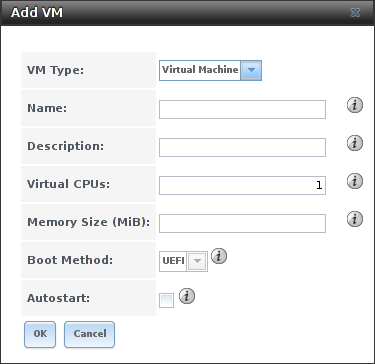
Fig. 14.1.1 Add VM
VM configuration options are described in Table 14.1.1.
| Setting | Value | Description |
|---|---|---|
| VM Type | drop-down menu | Select the VM type. Choices are Virtual Machine for a typical instance, or Docker VM for a special VM to run Docker. |
| Name | string | Enter a name to identify the VM. |
| Description | string | Enter a short description of the VM or its purpose. |
| Virtual CPUs | integer | Select the number of virtual CPUs to allocate to the VM. The maximum is 16 unless the host CPU limits the maximum. The VM operating system might also have operational or licensing restrictions on the number of CPUs. |
| Memory Size (MiB) | integer | Allocate the amount of RAM in mebibytes for the VM. |
| Boot Method | drop-down menu | Select UEFI for newer operating systems, or UEFI-CSM for (Compatibility Support Mode) older operating systems that only understand BIOS booting. |
| Autostart | checkbox | Set to start the VM automatically when the system boots. |
14.2. Adding Devices to a VM¶
After creating the VM, click it to select it, then click Devices and Add Device to add virtual hardware to it:
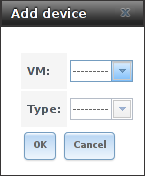
Fig. 14.2.1 Add Devices to a VM
Select the name of the VM from the VM drop-down menu, then select the Type of device to add. These types are available:
Note
Docker VMs are not compatible with VNC connections.
Figure 14.2.2 shows the fields that appear when Network Interface is the selected Type.
14.2.1. Network Interfaces¶
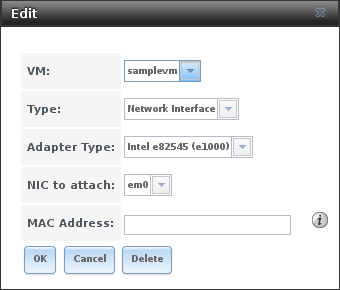
Fig. 14.2.2 VM Network Interface Device
The default Adapter Type emulates an Intel e82545 (e1000) Ethernet card for compatibility with most operating systems. VirtIO can provide better performance when the operating system installed in the VM supports VirtIO paravirtualized network drivers.
If the system has multiple physical network interface cards, use the Nic to attach drop-down menu can be used to specify which physical interface to associate with the VM.
By default, the VM receives an auto-generated random MAC address. To override the default with a custom value, enter the desired address into the MAC Address field.
14.2.2. Disk Devices¶
Zvols are typically used as virtual hard drives. After creating a zvol, associate it with the VM by selecting Add device, choose the VM, select a Type of Disk, select the created zvol, then set the Mode. If a specific sector size is required, enter the number of bytes into Disk sector size. The default of 0 leaves the sector size unset.
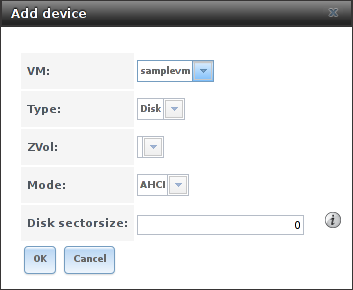
Fig. 14.2.3 VM Disk Device
AHCI emulates an AHCI hard disk for best software compatibility. VirtIO uses paravirtualized drivers and can provide better performance, but requires the operating system installed in the VM to support VirtIO disk devices.
14.2.3. Raw Files¶
Raw Files are similar to Zvol disk devices, but the disk image comes from a file. These are typically used with existing read-only binary images of drives, like an installer disk image file meant to be copied onto a USB stick.
After obtaining and copying the image file to the FreeNAS® system, select Add device, choose the VM, select a Type of Raw File, browse to the image file, then set the Mode. AHCI emulates an AHCI hard disk for best software compatibility. VirtIO uses paravirtualized drivers and can provide better performance, but requires the operating system installed in the VM to support VirtIO disk devices.
If a specific sector size is required, enter the number of bytes into Disk sectorsize. The default of 0 leaves the sector size unset.
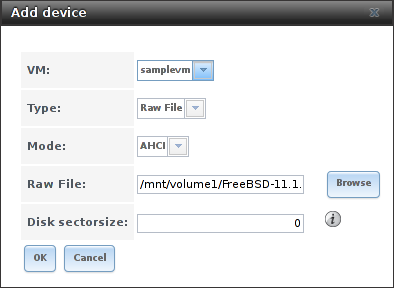
Fig. 14.2.4 VM Raw File Disk Device
14.2.4. CD-ROM Devices¶
Adding a CD-ROM device makes it possible to boot the VM from a CD-ROM image, typically an installation CD. The image must be present on an accessible portion of the FreeNAS® storage. In this example, a FreeBSD installation image is shown:
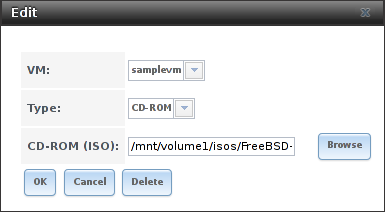
Fig. 14.2.5 VM CD-ROM Device
Note
VMs from other virtual machine systems can be recreated for use in FreeNAS®. Back up the original VM, then create a new FreeNAS® VM with virtual hardware as close as possible to the original VM. Binary-copy the disk image data into the zvol created for the FreeNAS® VM with a tool that operates at the level of disk blocks, like dd(1). For some VM systems, it is best to back up data, install the operating system from scratch in a new FreeNAS® VM, and restore the data into the new VM.
14.2.5. VNC Interface¶
VMs set to UEFI booting are also given a VNC (Virtual Network Computing) remote connection. A standard VNC client can connect to the VM to provide screen output and keyboard and mouse input.
Figure 14.2.6 shows the fields that appear when VNC is the selected Type.
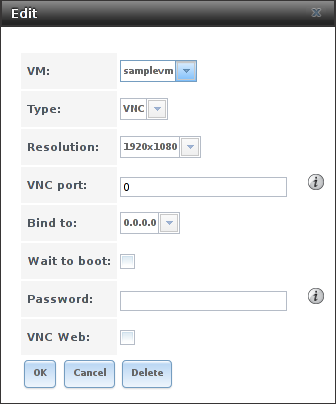
Fig. 14.2.6 VM VNC Device
The Resolution drop-down menu can be used to modify the default screen resolution used by the VNC session.
The VNC port can be set to 0, left empty for FreeNAS® to assign a port when the VM is started, or set to a fixed, preferred port number.
Select the IP address for VNC to listen on with the Bind to drop-down menu.
Set Wait to boot to indicate that the VNC client should wait until the VM has booted before attempting the connection.
To automatically pass the VNC password, enter it into the Password field. Note that the password is limited to 8 characters.
To use the VNC web interface, set VNC Web.
Tip
If a RealVNC 5.X Client shows the error
RFB protocol error: invalid message type, disable the
Adapt to network speed option and move the slider to
Best quality. On later versions of RealVNC, select
,
click Expert, ProtocolVersion, then
select 4.1 from the drop-down menu.
14.2.6. Virtual Serial Ports¶
VMs automatically include a virtual serial port.
/dev/nmdm1Bis assigned to the first VM/dev/nmdm2Bis assigned to the second VM
And so on. These virtual serial ports allow connecting to the VM console from the Shell.
Tip
The nmdm
device is dynamically created. The actual nmdm name can
differ on each system
To connect to the first VM:
cu -s 9600 -l /dev/nmdm1B
See cu(1) for more information on operating cu.
14.3. Running VMs¶
Select to see a list of configured VMs. Configuration and control buttons appear at the bottom of the screen when an individual VM is selected with a mouse click:

Fig. 14.3.1 VM Configuration and Control Buttons
The name, description, running state, VNC port (if present), and other configuration values are shown. Click on an individual VM for additional options.
Some standard buttons are shown for all VMs:
- Edit changes VM settings.
- Delete removes the VM.
- Devices is used to add and remove devices to this VM.
When a VM is not running, these buttons are available:
- Start starts the VM.
- Clone clones or copies the VM to a new VM. The new VM is given the same name as the original, with _cloneN appended.
When a VM is already running, these buttons are available:
- Stop shuts down the VM.
- Power off immediately halts the VM, equivalent to disconnecting the power on a physical computer.
- Restart restarts the VM.
- Vnc via Web starts a web VNC connection to the VM. The VM must have a VNC device, and VNC Web enabled in that device.
14.4. Deleting VMs¶
A VM is deleted by clicking the VM, then Delete at the bottom of the screen. A dialog will show any related devices that will also be deleted and ask for confirmation.
Tip
Zvols used in disk devices and image files used in raw file devices are not removed when a VM is deleted. These resources can be removed manually after it is determined that the data in them has been backed up or is no longer needed.
14.5. Docker/Rancher VM¶
Docker is Open Source software for automating application deployment inside containers. A container provides a complete filesystem, runtime, system tools, and system libraries, so applications always see the same environment.
Rancher is a GUI tool for managing Docker containers.
FreeNAS® runs the Rancher GUI as a separate VM.
14.5.1. Rancher VM Requirements¶
The system BIOS must have virtualization support enabled for a Docker VM to run properly after installation. On Intel systems this is typically an option called VT-x. AMD systems generally have an SVM option.
20 GiB of storage space is required for the Rancher VM. For setup, the SSH service must be enabled.
The Rancher VM requires 2 GiB of RAM while running.
14.5.2. Create the Rancher VM¶
Click VMs, then the Add VM button. Set the VM Type to Docker VM. Enter RancherUI for the name, Rancher UI VM for the Description, leave the number of Virtual CPUs at 1, and enter 2048 for the Memory Size. To have the Rancher VM start when the FreeNAS® system boots, enable the Autostart option. Click OK to create the virtual machine.
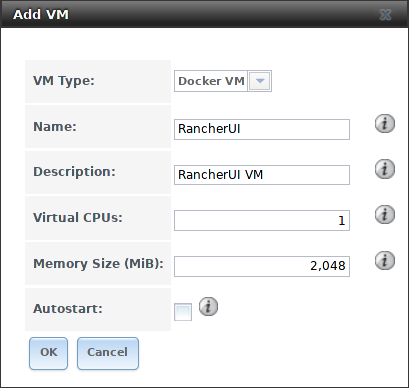
Fig. 14.5.1 Rancher VM Configuration
A location to store the disk image must now be chosen. In this example, a dataset called vm-storage has already been created as a location to store VM data. Click VMs, then click on the RancherUI line to select it. Click on the Devices button to show the devices attached to that VM. Click on the RAW device to select it, then click the Edit button. In the Raw File field, browse to the dataset and select it. Then add a filename by typing /rancherui.img at the end of the path in the text box.
Set the Disk boot option, enter a password for the
rancher user in the Password field, then enter
20G in the Disk size field. Click OK to save
the device.
Note
The Password will fail if it contains a space.
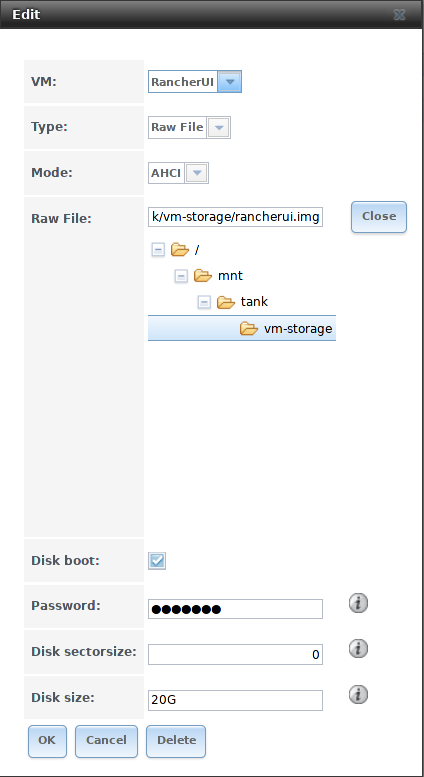
Fig. 14.5.2 Rancher Image Storage
14.5.3. Start the Rancher VM¶
Click VMs, then click on the RancherUI line to select it. Click the Start button and then Yes to start the VM.
The first time the Rancher VM is started, it downloads the Rancher disk image file. How long this takes to complete depends on the speed of the network connection. A status dialog reports the progress of the download.
After the image is downloaded, the VM starts.
14.5.4. Installing the Rancher Server¶
Click VMs and locate the line for the RancherUI VM. The
Info column shows the Com Port for the
Rancher VM. In this example, /dev/nmdm3B is used.
Further setup of the Rancher VM is done from the command line. Use an SSH client to connect to the FreeNAS® server. Remember that this requires the SSH service to be running. Depending on local configuration, it might also require changes to the setting of the service, like allowing root user login with a password.
At the FreeNAS® console prompt, connect to the Rancher VM with
cu, replacing
/dev/nmdm3B with the value from the RancherUI
Info column:
cu -l /dev/nmdm3B
If the terminal does not show a rancher login: prompt,
press Enter.
Enter rancher as the username, press Enter, then type the
password that was entered when the raw file was created above and
press Enter again. After logging in, a
[rancher@rancher ~]$ prompt is displayed.
Ensure Rancher has functional networking and can ping an outside website. Adjust the VM Network Interface and reboot the VM if necessary.
Download and install the Rancher system with this command:
sudo docker run -d --restart=unless-stopped -p 8080:8080 rancher/server
Note
If the error Cannot connect to the Docker daemon
is shown, run sudo dockerd. Then give the
sudo docker run command above again.
Installation time varies with processor and network connection speed, but typically takes a few minutes. After the process finishes and a command prompt is shown, type this command:
ifconfig eth0 | grep 'inet addr'
The first value is the IP address of the Rancher server. Enter the IP
address and port 8080 as the URL in a web browser. For example,
if the IP address was 10.231.3.208, enter
10.231.3.208:8080 as the URL in the web browser.
The Rancher server takes a few minutes to start. The web browser might
show a connection error while the Rancher GUI is still starting. If
the browser shows a connection has timed out or a similar
error, wait one minute and try again.
In the Rancher GUI, click Add a host and enter the same IP address and port number. Click Save to save the information.
For more information on using Rancher, see the Rancher Quick Start Guide.